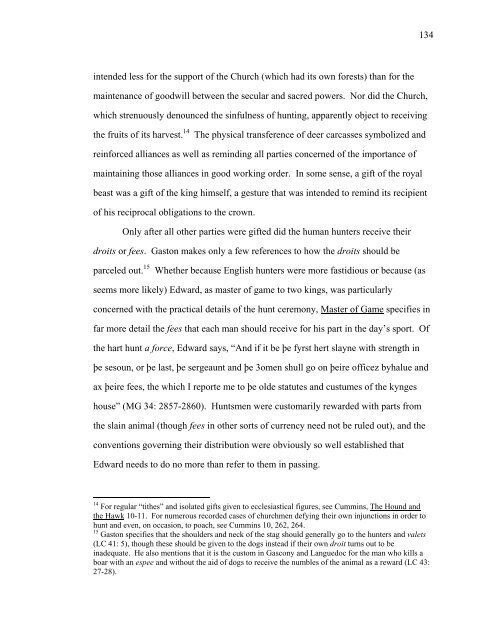Chapter 4 The Gift.pdf - eCommons@Cornell
Chapter 4 The Gift.pdf - eCommons@Cornell
Chapter 4 The Gift.pdf - eCommons@Cornell
You also want an ePaper? Increase the reach of your titles
YUMPU automatically turns print PDFs into web optimized ePapers that Google loves.
intended less for the support of the Church (which had its own forests) than for the<br />
maintenance of goodwill between the secular and sacred powers. Nor did the Church,<br />
which strenuously denounced the sinfulness of hunting, apparently object to receiving<br />
the fruits of its harvest. 14 <strong>The</strong> physical transference of deer carcasses symbolized and<br />
reinforced alliances as well as reminding all parties concerned of the importance of<br />
maintaining those alliances in good working order. In some sense, a gift of the royal<br />
beast was a gift of the king himself, a gesture that was intended to remind its recipient<br />
of his reciprocal obligations to the crown.<br />
Only after all other parties were gifted did the human hunters receive their<br />
droits or fees. Gaston makes only a few references to how the droits should be<br />
parceled out. 15 Whether because English hunters were more fastidious or because (as<br />
seems more likely) Edward, as master of game to two kings, was particularly<br />
concerned with the practical details of the hunt ceremony, Master of Game specifies in<br />
far more detail the fees that each man should receive for his part in the day’s sport. Of<br />
the hart hunt a force, Edward says, “And if it be þe fyrst hert slayne with strength in<br />
þe sesoun, or þe last, þe sergeaunt and þe 3omen shull go on þeire officez byhalue and<br />
ax þeire fees, the which I reporte me to þe olde statutes and custumes of the kynges<br />
house” (MG 34: 2857-2860). Huntsmen were customarily rewarded with parts from<br />
the slain animal (though fees in other sorts of currency need not be ruled out), and the<br />
conventions governing their distribution were obviously so well established that<br />
Edward needs to do no more than refer to them in passing.<br />
14 For regular “tithes” and isolated gifts given to ecclesiastical figures, see Cummins, <strong>The</strong> Hound and<br />
the Hawk 10-11. For numerous recorded cases of churchmen defying their own injunctions in order to<br />
hunt and even, on occasion, to poach, see Cummins 10, 262, 264.<br />
15 Gaston specifies that the shoulders and neck of the stag should generally go to the hunters and valets<br />
(LC 41: 5), though these should be given to the dogs instead if their own droit turns out to be<br />
inadequate. He also mentions that it is the custom in Gascony and Languedoc for the man who kills a<br />
boar with an espee and without the aid of dogs to receive the numbles of the animal as a reward (LC 43:<br />
27-28).<br />
134

















